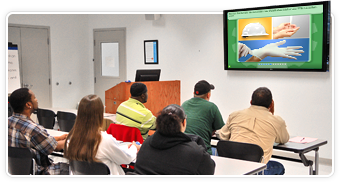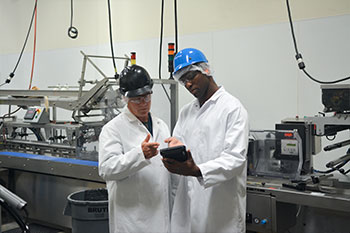7 Steps To Improve Food Industry Training Programs

Life in a food manufacturing plant can be hectic and unpredictable, to say the least. On the positive side – no two days are ever the same. On the not so positive side – YIKES – keeping track of all that needs to be done while working through “challenges and opportunities” is more turbulent than hurricane force winds!
To keep your head on straight, your training programs should be the first thing pulled out of the tool kit when dealing with a change or issue. So how do you create an agile and strategic program?
Robust training programs are comprised of seven key elements. Here is a checklist to get started on the right foot
Robust training programs are comprised of seven key elements. Here is a checklist to get started on the right foot:
1. Develop an annual schedule.

Be sure that you approach training with a well thought out strategy and clearly defined (and agreed upon) goals. Set a schedule where training topics are assigned each month that correspond with other plant activities. Devising a plan where there is a link between learning and real-life experience reinforces concepts and improves overall effectiveness of your regimen. A user-friendly learning management system tailored to the needs of food manufacturing facilities will be your biggest asset in this area.
2. Fully develop and vet training materials with all applicable departments.
If the material you are teaching is not relevant to the audience, then you’ve wasted time and money. It’s that simple. Be sure to align training materials with corporate objectives, plant operations, and overall goals for safety and productivity. Without vetting your training program, you could also miss an opportunity to make the most out of time invested in training. Address operations-specific issues in one session as opposed to several. This increases comprehension and improves agility in responding to issues, such as changing SOPs or safety concerns.
Shifting the mindset that training is just an L&D responsibility will pay huge dividends. Among companies with a cross-functional learning management team, only 6% are unable to provide adequate food safety training. While 76% of companies without cross-functional learning management can’t provide adequate food safety training. That’s far too much risk. (For more great research, see the report “Why Some Training Programs Fail Where Others Succeed.”)
3. Determine methods and mode of delivery in advance.

Approach training systematically. If there is not a system of delivery, validation of comprehension, or protocol for record keeping, it’s a red flag for administrative headaches down the line, or worse audit non-compliance. Be proactive and unify training systems across all operations.
4. Develop awareness programs.
Help carry the message throughout the month and keep hot topics out in front of the plant population. Training doesn’t stop when workers leave the classroom. Awareness programs create a valuable opportunity to reinforce positive behavior change. Creating weekly safety meetings, on-the-floor reminders of recent training, and even looping videos in the break room are just a few recommendations. Most importantly, these suggestions will help you reinforce learning concepts, keep employees on board with up-to-date information, and clearly define initiatives.
5. Make everyone accountable for putting lessons into practice.

Approach this from the top down and bottom up, with no exceptions. Create an internal auditing system for checks and balances. All employees at all levels should be subject to internal audits of training comprehension and practical application. Schedule remediation and follow up as necessary. Taking the time to audit employee behavior may uncover areas for improvement in operations. You may be surprised how this approach actually empowers employees to drive food safety and quality improvements that may go unnoticed otherwise.
6. Include non-production departments – they have a big impact on everyday activities.

This concept is quite simple: everyone should be held to the same standard when it comes to learning, comprehension, and application of training concepts. If an office employee is on the plant floor during an audit, they can pose the same risks as a frontline worker. Approach training with equal importance for all employees, everyone in the plant should remain up to date on the issues pertinent to operations.
7. Provision a forum for Q&A and open discussion.

Food industry frontline workers, especially in manufacturing, are vital to maintaining public health. Leverage internal communication to reinforce the importance of the work that they do.
Creating a forum that is open to employee feedback gives them the opportunity to take ownership in the company’s success. Reinforce a culture of safety that celebrates employees as the first line of defense in maintaining regulatory compliance and product integrity. Connect employees to the big picture. Their feedback is crucial to keeping training programs agile, up to date, and relevant in their day-to-day challenges.
An agile training program takes all the ingredients listed above. Mix, match, customize, modify, and rearrange for the best results. Updating training materials using relevant pictures and actual plant events to highlight a topic (good or bad) will cement the concept by making it real. Keeping programs fluid will allow for greater employee engagement.
Contact us for more tips or help creating your food safety training program.







